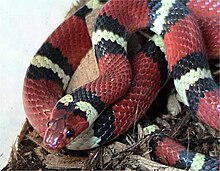Kingsnakes
| Kingsnakes | |
|---|---|
 |
|
| Scarlet kingsnake (Lampropeltis elapsoides) | |
| Scientific classification | |
| Kingdom: | Animalia |
| Phylum: | Chordata |
| Class: | Reptilia |
| Order: | Squamata |
| Suborder: | Serpentes |
| Family: | Colubridae |
| Subfamily: | Colubrinae |
| Genus: |
Lampropeltis Fitzinger, 1843 |
| Synonyms | |
|
Ablabes, Anguis, Bellophis, Calamaria, Coronella, Herpetodryas, Natrix, Ophibolus, Osceola, Phibolus, Pseudelaps, Zacholus |
|
Ablabes, Anguis, Bellophis, Calamaria, Coronella, Herpetodryas, Natrix, Ophibolus, Osceola, Phibolus, Pseudelaps, Zacholus
Kingsnakes are colubrid snakes, members of the genus Lampropeltis, which include milk snakes and four other species. Among these, there are approximately 45 recognized subspecies.
Lampropeltis means "shiny shield", a name given to them in reference to their smooth dorsal scales.
Kingsnakes use constriction to kill their prey and tend to be opportunistic when it comes to their diet; they will eat other snakes (ophiophagy), including venomous snakes. Kingsnakes will also eat lizards, rodents, birds, and eggs. The common kingsnake is known to be immune to the venom of other snakes and does eat rattlesnakes, but it is not necessarily immune to the venom of snakes from different localities.
The "king" in the name (as with the king cobra) refers to this preying on other snakes.
Kingsnakes such as the California kingsnake can exert twice as much constriction force relative to body size as ratsnakes and pythons. Scientists believe such strong coils may be an adaptation to snake and other reptile prey, which can sustain lower blood-oxygen levels before asphyxiating.
The majority of kingsnakes have quite vibrant patterns on their skins. Some species of kingsnake, such as the scarlet kingsnake, Mexican milk snake, and red milk snake, have coloration and patterning that can cause them to be confused with the highly venomous coral snakes.
...
Wikipedia
